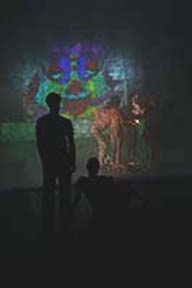The Less We Believe It: Time Track at the Ritz
Camille LeFevre reviews Time Track Productions' "The Closer I Get, The Less I Believe It," a study of the "uncanny valley" between humanness and its simulacra. She finds that it doesn't ever quite come into focus.

Midway through Time Track Productions’ new work, “The Closer I Get, the Less I Believe It,” last weekend, performer Robert Haarman—as a videotaped, digitally manipulated, talking head projected on a giant scrim—intoned the following: “Someday it will occur to you that you’re bored. But you won’t be able to get up.”
OK. Well, we couldn’t get up out of our seats at the Ritz Theater because we’re good Minnesotans. Meaning, despite the shifting in our seats, yawns, sighs and head scratching, leaving this show midway would have been rude. So we stayed put. Plus, maybe we really weren’t that bored.
Because maybe something was going on. Was Haarman’s statement some sort of meta-textual discourse with the audience about states of being, wherein the supposed responses of the audience were boldly, deliberately solicited and then responded to in the work? Or were Paula Mann, the choreographer and stage director, and Steve Paul, who wrote the script and mixed the media, just really naïve? Unfortunately, I’d have to venture the latter.
It was a sweet sort of naivete, though, that was ardently trying to say something profound about humans, technology, and memory. And the ten performers wholeheartedly undertook the task. A plethora of images—from the talking heads to pedestrian street scenes to a green-lined computer-generated grid—flickered across a variety of scrims and screens; and those diaphanous curtains were pulled to and fro across the stage to create various strata of images; and the dancers raced back and forth across the stage between the scrims in various states of emotion and interaction.
The piece was comprised of layers, in other words, that constantly shift—like veils, mists, filaments—to create an accumulation of surfaces. Essentially, that was the work. While vague ideas were occasionally put forth, they were never developed. They came and went, slipping away unexplored like the images that appeared, then disappeared, from the scrims.
The program note explained that that subtitle of “The Closer I Get,” which is “An Odyssey Through the Uncanny Valley of Simulated Humanity,” “refers to the writings of Masahiro Mori, who found in his research of the reactions to the creation of artificial humans (both robotic and cgi [computer generated imagery]), that as the synthetic people looked more ‘real’ there was a dramatic drop-off in believability.” This finding was played out, at times, by two groups of dancers: those in street clothes who were supposedly real, and those in sleeveless unitards who represented the cyborgs and perhaps virtual reality.
As expected, the cyborgs’ movements were more robotic; the street-clothed dancers’ a more natural modern dance idiom. And, of course, they crossed over. During a scene in which everyone lip-synced to the Carpenters’ “Top of the World,” order broke down and movements overlapped. Mayhem ensued. Elsewhere, performers walked around with arms out in front of them, wrists bent down, and heads back like zombies. So the notion of who’s more human was purposefully obscured.
Nora Jenneman, when not wearing a long blond wig and lusciously smoothing the air with her arms, was another digitized talking head. Her virtual circus barker voice asked us to “Come; relive your memories. Live out your fantasies. It’s the excitement you know you desire.” But what those memories or fantasies are was never clear. There was some disrobing, but nothing erotic or fantastical about it. There was a lot of interplay between image and performer (dancers moving behind digital shadows of their figures, for instance), but neither was bizarre, perverse or re-contextualized enough to render them surreal.
At times, the goings-on had a madcap feel, as if the innocent hijinks enacted by the Monkees or the Beatles in their pre-music-video films were an inspiration. And the end of the piece, in which all joined together carrying giant flowers (genetically modified?), had a 1960s, let’s-all-get-along, flower-power vibe enhanced by music by Captain Beefheart.
In 2003, Paula Mann disbanded her 1980s troupe, Paula Mann Dance, and started Time Track Productions with her husband, Steve Paul. The company’s first work, “All That Is Solid Melts Into Air,” was an innovative look at the 100-year relationship between human movement and the moving image, that evolved from an organic historical study of the pioneering work of Carl Ramsey and Eadweard Muybridge to a fractured look at contemporary life.
TTP’s second venture, “The Train Wreck Is Proceeding Nicely,” was an overwrought take on J. Robert Oppenheimer’s state of mind. With “The Closer,” TTP has seemingly entered the 21st century by way of the 1960s, with the naivete of the 1950s still intact. Where has the smartness, the insight, the resonance that TTP enticed us with in “All That Is Solid” gone? “The Closer” offers a sweet state of abstraction in which images and ideas are purveyed, but not illuminated.